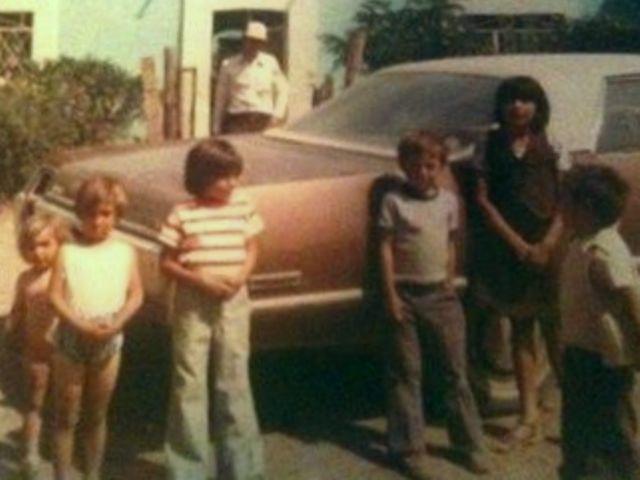
Mexican Families

Figure 1.-- The photo shows a Mexican family in a village near Durango during the 1970s or early 1980s. It shows six siblings near the family car. Many Mexican families could afford a car necause inexpensive used car were available from the United States. In addition the nationalized Mexican oil company kept gas prices low. Notice that the children are dressed just like Americans.
|
|
The family is an important topic in any assessment of Mexicam life. As in much of Latin America, fmily tends to transcend individual through generations. We do not yet fully understand this, but surely the region's Hispanic Catholic culture is central factor. The Spanish ruled Mexico for three centuries, but Mexico is a largely Mestizo country and thus Narive American culture has also played a role in develpong the modern Exican family. Kinship ties are a very important factoir of Mexican life. Young Mexicans are less likely than Americans to leave the home until marriage, especially the girls. One researcher reports that words used by Mexicans to describe the family reflect uniformily positive values, including: unity, children, love, home, well-being, parents, understanding, tenderness, education, happiness, and support [Salles and Tuirán] The family is where Mexicans find affection, solidarity, and care in their everyday life. This simple fact, the importance of the family, ripples through all aspect of national life, politics, economy, culture, social relarionships and much more. There are both positive and negative consequences. Families ties provide support in a country which because of a generalized economic failure, the state does not have the resources to build a safety net. But it also means that rather than making family sacrifices to ensure that children get a sound education, many children drop out of school to support the family. The basic trend affecting the Mexican family has been the migration if rural compesinos to urban areas. And the high birth rate common in rural reas has continued as families adjust to urban life. Most of these new migrant do not have the education to obtain decent jobs. And the socialist policies of Mexican governments a well as endemic corruption and wide-spread drug related criminality have ensured that the private sector can not create the needed jobs for swelling urban populations. Mexico has one advantage not open to most countries. It has a long border with the Unioted States thst is reltively easy to cross. Thus many Mexicans have sought job oppotunities in America. As a result, very large numbers of Mexican families have relatives in America. Trade with the United States has also been hugely beneficial to Mexico. As a result, there has been a growth of the Mexican middle class. Despite the lack of job opportunities generally, many more Mexicans have enteed the middle class and able to afford decent housing, cars, and other conmsumer products. For HBC not only are these cultural and economic currents important, but family images provide a great deal of information about fashion and helps to put the information we have collected on boys' fashions in perspective.
The United States Navy after what became known as the Tampico Affair seized the port of Tampico. An American after the seizure of Tampico took this photograph of a Mexican family in 1914. They were farming cotton, but notice only a small patch. It is presumably a small family farm, but based on the cotton patch not large enough tp generate much income. The children who look to be all boys 5-10 years old wear rounded-crown hats, long-sleeve shirts, and knee pants.
Hwere we see a Mexican nestizo family having an outing to Xochimilco in 1945. Xochimilco is one of the 16 boroughs within Mexico City. The borough is centered on the formerly independent city of Xochimilco which has been incoporated into Mexico City with its enormous expnsion. Xochimilcowas was located on the southern shore of the historic pre-Hispanic Lake Xochimilco. This is a kind of lake in the desert. Xochimilco is all that is left of the five lakes within the Valley of Mexico. These lakes were the home of many Mesoamerican cultures, including the Teotihuacanos, the Toltecs, and the Aztecs. Xochimilco was a bay in the larger Lake Texcoco on which the Aztec capital was built. The conquest of Mexico was fought on and around the lake. Xochimilco today is an enchanting place of tanqulity, somewhar spoiled by the tourist trade in the middle of a bussling, colossal city. It was made a World Heritage Site (1987). It was known for its colorful flower market. The walled canals are lined with gardens and curtains of trees. Tourists can enjoy a ride the on brightly painted and decorated trajineras ( traditional flat-bottomed boat). This watery surrounding dominated the landscape of the Aztec Anahuac--core of Mexico. Small artificial islands, called chinampas, are used to grow flowers, vegetables, and ornamental plants.
Durango Family (about 1980)
The photo shows a Mexican family in a village near Durango during the 1970s or early 1980s (figure 1). It shows six siblings near the family car. Many Mexican families could afford a car because inexpensive used car were available from the United States. In addition the nationalized Mexican oil company kept gas prices low. Notice that the children are dressed just like Americans.
HBC

Navigate the Boys' Historical Clothing Web Site:
[Return to the Main country family page]
[Introduction]
[Activities]
[Biographies]
[Chronology]
[Clothing styles]
[Countries]
[Bibliographies]
[Contributions]
[FAQs]
[Glosario en Español]
[Images]
[Links]
[Registration]
[Boys' Clothing Home]
Navigate the HBC Mexican pages
[Mexican choirs]
[Mexican Scouts]
[Mexican school uniforms]
[Mexican communions]
Navigate the Boys' Historical Clothing national pages:
[Return to the Main Mexican page]
[Return to the Main Central American page]
[Return to the Main Latin American page]
[Return to the Main countries page]
[Belize]
[Costa Rica]
[Cuba]
[Guatemala]
[Honduras]
[Nicaraga]
[El Salvador]
[Panama]
[United States]
Created: 5:49 PM 7/11/2012
Last updated: 3:23 AM 4/4/2018



